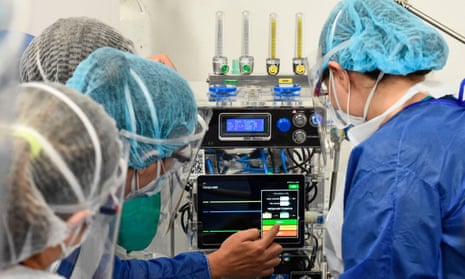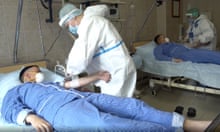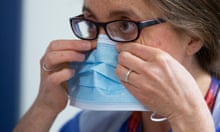Symptoms of Covid-19 appear to fall into six different groupings, researchers have revealed, in work they say could help to predict whether a patient will end up needing a ventilator or other breathing support.
The team say the findings could give healthcare providers several days advanced warning of demand for hospital care and respiratory support.
But it could also help flag patients at risk of becoming seriously ill, meaning home support, such as an oxygen meter or nurse visits, could be provided so that any deterioration is spotted quickly and hospital attendance is prompt. At present, the team added, the average time to get to hospital with Covid-19 is 13 days.
“Anything you can do earlier to stop people coming in half-dead is going to increase the chance of survival and also stop clogging up hospital beds unnecessarily,” said Prof Tim Spector of King’s College London, a co-author of the work.
The study, which is published on medRxiv and has not yet been peer-reviewed, is based on data from the team’s app, which has more than 4 million users.
The researchers drew on data from 1,653 users who tested positive for Covid-19, reported persistent symptoms and regularly logged updates on their health and situation. Overall, 383 of these users made at least one trip to hospital, and 107 required either extra oxygen or ventilation.
The team then used machine learning algorithms – a type of artificial intelligence – to explore whether some symptoms, among the 14 monitored, cluster together. The results suggest six different groupings based on the type of symptoms, when they occurred, and their duration within the first 14 days of participants’ sickness.
And there was more. “We saw that there was a very clear gradient between these clusters and outcomes in terms of [participants’ need for] respiratory support,” said Dr Claire Steves, clinical senior author on the paper from King’s College London, adding other factors such as older age or certain pre-existing medical conditions were more common in some groups.
The six groupings, or “clusters”, are:
Cluster 1: Mainly upper respiratory tract symptoms, such as a persistent cough, with muscle pain also present. About 1.5% of patients in this group required respiratory support, with 16% making one or more trips to hospital. This was the most common cluster of symptoms, affecting 462 participants.
Cluster 2: Mainly upper respiratory tract symptoms, but also a greater frequency of skipped meals and fever. Of patients in this group 4.4% required respiratory support, with 17.5% making one or more trips to hospital.
Cluster 3: Gastrointestinal symptoms such as diarrhoea, but few other symptoms. While only 3.7% of patients in this group later needed respiratory support, almost 24% made at least one visit to hospital.
Cluster 4: Early signs of severe fatigue, continuous chest pain and cough. Of patients in this group 8.6% required respiratory support, with 23.6% making one or more trips to hospital.
Cluster 5: Confusion, skipped meals and severe fatigue. Of patients in this group 9.9% required respiratory support, with 24.6% making one or more trips to hospital.
Cluster 6: Marked respiratory distress including early onset of breathlessness and chest pain, as well as confusion, fatigue and gastrointestinal symptoms. Almost 20% of this group needed respiratory support and 45.5% made one or more visits to hospital. But this was the least common symptom cluster, affecting 167 participants.
The team said the first two clusters seem to be “milder” forms of Covid-19.
Similar groupings were found when the researchers repeated the work with data from 1,047 different app users, with the team adding headaches, and loss of smell and taste, which cropped up in all clusters, but the latter was longer lasting in milder cases.
The researchers say tracking symptoms improves the ability to predict the trajectory of a Covid-19 patient.
Spector said: “By recording all the symptoms and when they occur in something like a medical app you can significantly increase the ability to predict who is going to need hospital support, and potentially save lives.”
Based on the first five days of reported symptoms, together with patient characteristics such as age, sex and pre-existing medical conditions, the team could predict 79% of the time whether a patient would later need respiratory support. Using patient characteristics alone, this figure was just under 70%; chance would give a figure of 50%.
Quick GuideWill there be a second wave of coronavirus?
Show
In recent days the UK has seen a sudden sharp increase in Covid-19 infection numbers, leading to fears that a second wave of cases is beginning.
Epidemics of infectious diseases behave in different ways but the 1918 influenza pandemic that killed more than 50 million people is regarded as a key example of a pandemic that occurred in multiple waves, with the latter more severe than the first. It has been replicated – albeit more mildly – in subsequent flu pandemics. Until now that had been what was expected from Covid-19.
How and why multiple-wave outbreaks occur, and how subsequent waves of infection can be prevented, has become a staple of epidemiological modelling studies and pandemic preparation, which have looked at everything from social behaviour and health policy to vaccination and the buildup of community immunity, also known as herd immunity.
Is there evidence of coronavirus coming back in a second wave?
This is being watched very carefully. Without a vaccine, and with no widespread immunity to the new disease, one alarm is being sounded by the experience of Singapore, which has seen a sudden resurgence in infections despite being lauded for its early handling of the outbreak.
Although Singapore instituted a strong contact tracing system for its general population, the disease re-emerged in cramped dormitory accommodation used by thousands of foreign workers with inadequate hygiene facilities and shared canteens.
Singapore’s experience, although very specific, has demonstrated the ability of the disease to come back strongly in places where people are in close proximity and its ability to exploit any weakness in public health regimes set up to counter it.
In June 2020, Beijing suffered from a new cluster of coronavirus cases which caused authorities to re-implement restrictions that China had previously been able to lift. In the UK, the city of Leicester was unable to come out of lockdown because of the development of a new spike of coronavirus cases. Clusters also emerged in Melbourne, requiring a re-imposition of lockdown conditions.
What are experts worried about?
Conventional wisdom among scientists suggests second waves of resistant infections occur after the capacity for treatment and isolation becomes exhausted. In this case the concern is that the social and political consensus supporting lockdowns is being overtaken by public frustration and the urgent need to reopen economies.
However Linda Bauld, professor of public health at the University of Edinburgh, says “‘Second wave’ isn’t a term that we would use at the current time, as the virus hasn’t gone away, it’s in our population, it has spread to 188 countries so far, and what we are seeing now is essentially localised spikes or a localised return of a large number of cases.”
The overall threat declines when susceptibility of the population to the disease falls below a certain threshold or when widespread vaccination becomes available.
In general terms the ratio of susceptible and immune individuals in a population at the end of one wave determines the potential magnitude of a subsequent wave. The worry is that with a vaccine still many months away, and the real rate of infection only being guessed at, populations worldwide remain highly vulnerable to both resurgence and subsequent waves.
Prof Alastair Denniston of the University of Birmingham, and an expert in the use of artificial intelligence in healthcare, warned that the approach did not give a precise prediction of the risk of severe sickness, and said the results were based on data from app users, meaning they may not hold across the wider population.
But, he added, the study has merit. “This new use of symptom data is an important additional tool in helping us estimate risk in patients, and you could see how it could be helpful in trying to ensure people at highest risk get the extra monitoring and earlier intervention they need,” he said.
Louise Wain, British Lung Foundation professor of respiratory research at the University of Leicester and one of the leads of the Phosp-Covid long-term follow-up study, addedthe findings could also shed light on who might benefit most from medicines such as dexamethasone.
But, she said, questions remain. “We do still also need to understand how early disease trajectories relate to how quickly and completely people recover after they’ve had the virus, and whether they can be used to identify those at greatest risk of long-term effects.”








